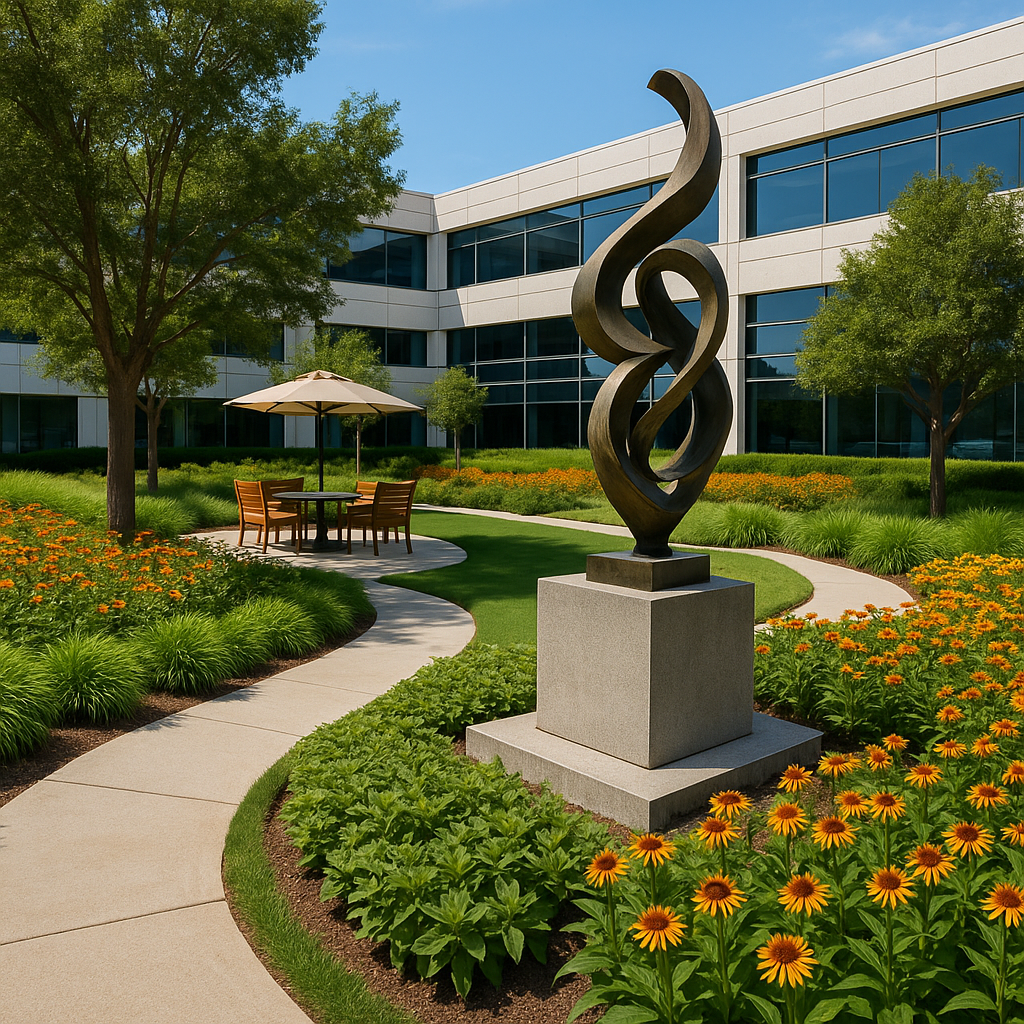A beautiful landscape does more than enhance aesthetics—it communicates values, inspires people, and solidifies brand presence. One of the most compelling trends in modern landscape design architecture is the integration of art elements that reflect and elevate corporate identity. Thoughtfully placed sculptures, murals, fountains, and interactive installations can transform open spaces into storytelling mediums, creating memorable and meaningful environments across office campuses and corporate facilities.
In this article, we explore how to integrate art within landscapes effectively. We’ll break down best practices, real-world examples, and strategies for aligning artistic expression with sustainability and business goals.
Why Art Belongs in Corporate Landscape Design
Visual Impact and Differentiation
In competitive urban environments, art-infused landscapes stand out. Corporate campuses that embrace creative features become visual landmarks, making a bold and memorable statement.
Reinforcing Brand Story and Culture
Art has the power to embody brand narratives, core values, and company mission. Whether it’s a custom sculpture that symbolizes innovation or a mural inspired by community history, these artistic features connect visitors and employees to the organization on a deeper level.
Enhancing Employee Engagement
Creative outdoor spaces boost morale, inspire creativity, and provide new settings for meetings and reflection. Employees feel more connected to work environments that stimulate and support them emotionally and intellectually.
Planning for Art in a Beautiful Landscape
Start with a Strategic Landscape Drawing
All successful projects begin with a comprehensive landscape drawing that accounts for art placement. The drawing should indicate sightlines, focal points, lighting plans, and interaction zones, ensuring art feels integrated—not incidental.
Collaborate Across Disciplines
Landscape architects, landscape contractors, and artists should collaborate from the beginning. Early alignment ensures that the art complements plantings, hardscaping, and movement patterns.
Choose Durable and Sustainable Materials
Select art pieces made from weather-resistant, eco-friendly materials such as recycled metal, locally quarried stone, or certified wood. This reflects your brand’s commitment to beautiful landscape sustainability.
Types of Artistic Landscape Features
Sculptures and Installations
Freestanding sculptures—whether abstract or representational—add grandeur and depth to plazas, courtyards, and green medians. They can mark transitions between zones or serve as standalone landmarks.
Murals and Vertical Art
Painted or tiled murals add vibrancy to building walls or retaining structures. These large-scale pieces provide visual storytelling opportunities and cultural connection.
Water Features with Artistic Elements
Fountains and water walls, when designed artistically, offer sensory appeal and symbolic meaning. Pairing sound, motion, and form fosters relaxation and harmony.
Interactive Art Spaces
Installations that invite participation—such as musical instruments, light-responsive sculptures, or writable walls—foster curiosity and collaboration.
Zones for Art Integration
Entryways and Welcome Plazas
Use art to establish identity immediately. Monument signs, branded sculptures, and thematic pieces can greet visitors and set the tone.
Courtyards and Meeting Areas
Combine art with seating and plantings to create emotionally enriching zones. These are ideal for outdoor collaboration or quiet reflection. Learn more in Beautiful Landscape Zones That Encourage Outdoor Meetings.
Walkways and Transition Spaces
Linear art elements such as kinetic sculptures or sequential murals enhance the walking experience. Explore walkway strategies in Beautiful Landscape Walkways That Inspire Daily Movement.
Multi-Building Campus Connections
Tie together disparate buildings with a shared art theme that repeats throughout the campus. This creates continuity and unity, detailed in Beautiful Landscape Layouts for Multi-Building Campuses.
Ensuring Long-Term Impact
Maintenance and Durability
Work with landscape contractors to maintain art pieces just as you would plant beds or lighting. Periodic cleaning, touch-ups, and inspections preserve appearance and safety.
Seasonal and Rotating Exhibits
Introduce change by rotating artworks or incorporating temporary installations. This keeps the space dynamic and invites repeated interaction.
Lighting for Night Visibility
Use LED or solar-powered spotlights to illuminate key art pieces. Proper lighting enhances evening ambiance and safety.
Examples of Art Serving Corporate Identity
- A tech company commissions a sculpture made from repurposed electronic waste to symbolize innovation and sustainability.
- A healthcare campus installs a mosaic mural showing community wellness scenes, reinforcing its patient-focused mission.
- A financial firm uses a granite monument engraved with company milestones to celebrate legacy and growth.
Final Thoughts
Art is not a luxury—it’s a strategic asset in landscape design that enriches identity, communicates values, and enhances daily experiences. A beautiful landscape that includes artistic elements speaks to your brand’s culture, commitment to excellence, and vision for the future.
With a skilled landscape contractor, thoughtful landscape drawings, and sustainable implementation, you can integrate art seamlessly into the natural and built environment—turning your campus into both a workplace and a gallery of inspiration.

